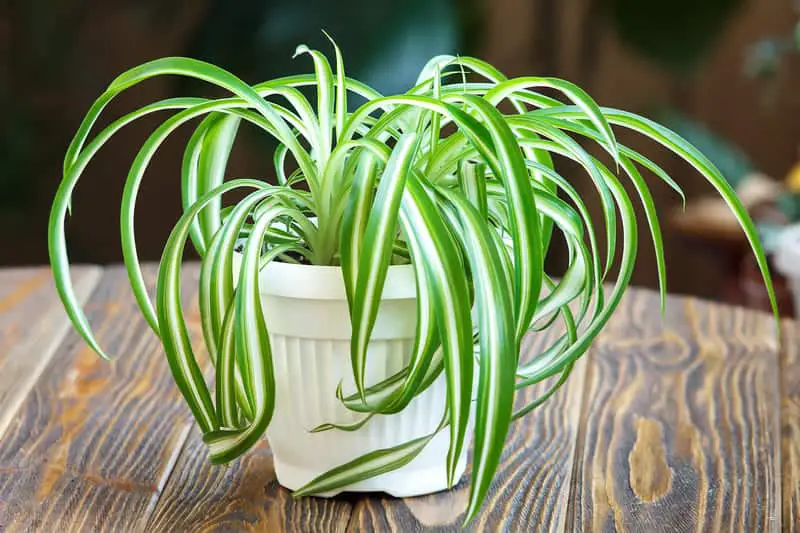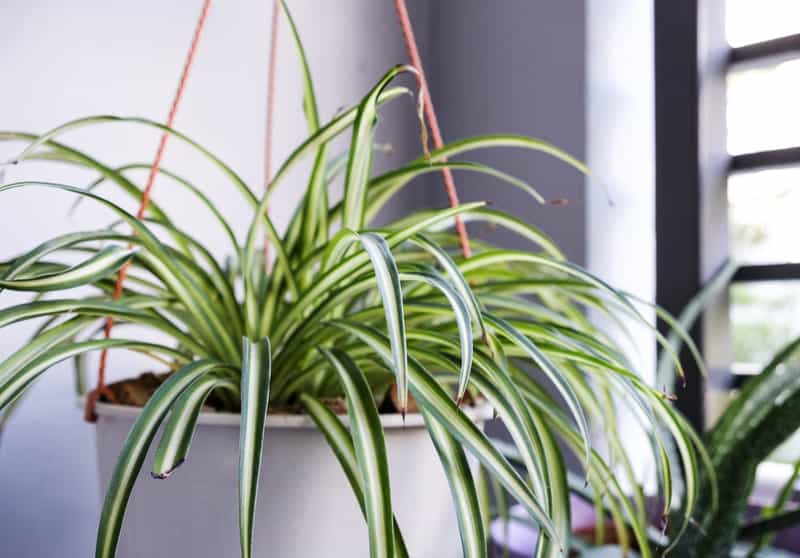The Spider plant gets its name from the little “spiderette” (also called a “pup”) or the mini version of the plant, which you often see hanging over the side of the pot. In really low lighting, it certainly resembles the insect from which it gets its name!
Spider plants do not like a location that is too sunny because it will cause its normally green and white leaves to bleach and discolour. However, indirect sunlight is essential for at least 8 and up to 10 hours a day to ensure your plant stays healthy.
Spider plants prefer bright, indirect light, but can tolerate low to medium light conditions. Avoid direct sunlight which can scorch the leaves.
These plants also adore humid conditions so read on to learn some tips for them to thrive.
Also check: How Often Should You Water a Spider Plant?
Where should you place a spider plant?
In general, Spider plants prefer a humid, warm location with a temperature of between 55 and 80 degrees Fahrenheit.
Some Spider plants (like the Hawaiian version) prefer it warmer than colder so these plants are definitely happier placed indoors.
In fact, Spider plants are a best seller for indoor household and office plants because people enjoy their colour and shape in places where light is often not so good and the plants bring nature indoors.
The best situation for all Spider plant varieties is in indirect sunshine but they will tolerate quite low light conditions. So the perfect spot is near a sunny window in a steamy bathroom although not in direct sunlight!
Will Spider plants grow in shade?
Spider plants grow happily in the shade as these plants prefer indirect sunlight, so a shady spot often provides them with really good leaf colour. Shade is also beneficial because they do not dry out rapidly, which is their preference.
To keep them looking healthy, have a mister close by your plant and spray it if the weather is very sunny. Be careful not to put Spider plants in direct sunshine because their leaves get sunburnt.
Also check: How Much Sun Does Basil Need?
Can Spider plants live in low light?
They are tolerant of low light and in fact, their colour often looks better because they really don’t enjoy the light that is direct because it may bleach their leaves.
This is why Spider plants are often placed in shady corners in offices, where they grow reasonably well. It’s a good idea to occasionally give them a few hours in a sunnier spot to boost growth.
The main rule to not to place them in direct sunlight but they can grow happily in corners, or on tabletops with a mix of fluorescent lighting and indirect sunshine.
If they lose their vitality, just move them for a few days, check the dryness of the soil and water if needed.
More: How Big Do Spider Plant Get
Can Spider plants grow outdoors?
If you want to grow them outside, you must ensure that all danger of frost is passed because they cannot survive frost. They do occur naturally in the wild, normally in warm conditions often with plentiful rainfall.
That said, they make lovely additions to an outdoor garden or patio, if you consider them as annuals. There may be some sunburnt leaves or browning of leaves if they get too dry or excessive direct sunlight.
So be aware of the conditions they enjoy and make sure the location for planting suits them. Just make sure you have some of its “spiderettes” already planted up and keep these indoors just in case so that they can remain cosy indoors next winter no matter what happens to their relatives outdoors.
More: How Much Sun Does an Aloe Vera Plant Need?
FAQs
Why does my Spider plant have brown leaves?
Spider plants are normally vigorous plants with spiked green or green and white striped leaves. When their leaves turn brown, this is a sign that they are unhappy.
- First, check the lighting. If it is direct, by now you know that you must move them to a place with indirect light.
- Secondly, is the location humid? This is what your Spider plant prefers, so mist the leaves now and then.
- Are you watering your Spider plant regularly? Brown leaves are often the result of inconsistent watering – too much or too little. So it’s time to remove those brown leaves and think about watering your plant regularly.
- Next, it is possible that your water contains too much fluoride so you could try distilling water and using this to water your plant. You can use boiled water to do this.
- Last of all, it might be that there is too much salt in your soil which can happen over time so try re-potting the plant and fingers crossed!
Can you make new plants from the mini plants they grow?
Spider plants do not make seeds. So the little “spiderette” grows on a long stem to allow it to move away from its mother, if grown in the wild. This allows the ideal spacing away from Mum so that it can then root in the soil while still attached to Mum!
So all this mini Spider plant needs is a pot of soil in which its roots are dipped. You will have a new plant in a month or so. Just check that the roots have taken and it is solidly placed in soil, then cut the stem and voila! A great present for anybody except those who don’t do spiders…
Do Spider plants flower?
Once in a while, your Spider plant will surprise you with a beautiful, white flower that contrasts with the gorgeous, spiky-shaped, green and white striped leaves. Some varieties offer yellow flowers. This flower appears on the same long, cream-coloured stem on which new “spiderettes” appear. They open at certain times of the day, normally when the light is at its brightest. Sometimes you get a whole stem with little white buds, which open. They are light-sensitive and close up again at night.
How many types of Spider plant are there?
Favourite varieties of Spider plant include:
- Variegated Spider plant: This is commonly sold in garden centres and has long, green and creamy-white shaped leaves, which are spiked at the ends. This plant never seems to stop growing and it produces “spiderettes” regularly, which hang decoratively over the edge of your flower pot.
- Hawaiian Spider plant: Also known as Golden Glow, this plant has deep green spiked leaves but a compact growing habit, so place this in offices and small rooms which need a smaller plant presence.
- Bonnie Spider plant: This variety looks similar to the Variegated Spider plant but the leaves seem to curl and make really interesting visual patterns. By contrast to the variegated variety, its flowers are usually yellow and illustrators love drawing these!
- Zebra Spider plant: This version grows very quickly and takes its name from the resemblance to the animal. A delightful addition to any room!
- Variegatum Spider plant: This Spider plant is almost the exact opposite of number 1. Its leaves are green in the middle with white edges so this one is very striking and popular with gardeners. It also has the same curved leaves as Bonnie.
Interesting facts about Spider plants:
- Spider plants are non-toxic to both humans and pets; in fact, they are actually classed as edible, although I am not recommending this as a salad leaf!
- They are also recognised as houseplants that remove harmful substances for humans from the air, as determined in a NASA Clean Air Study. Spider plants are known to remove both formaldehyde and xylene, which are household air toxins. So overall this is a really good friend in your office or house!


